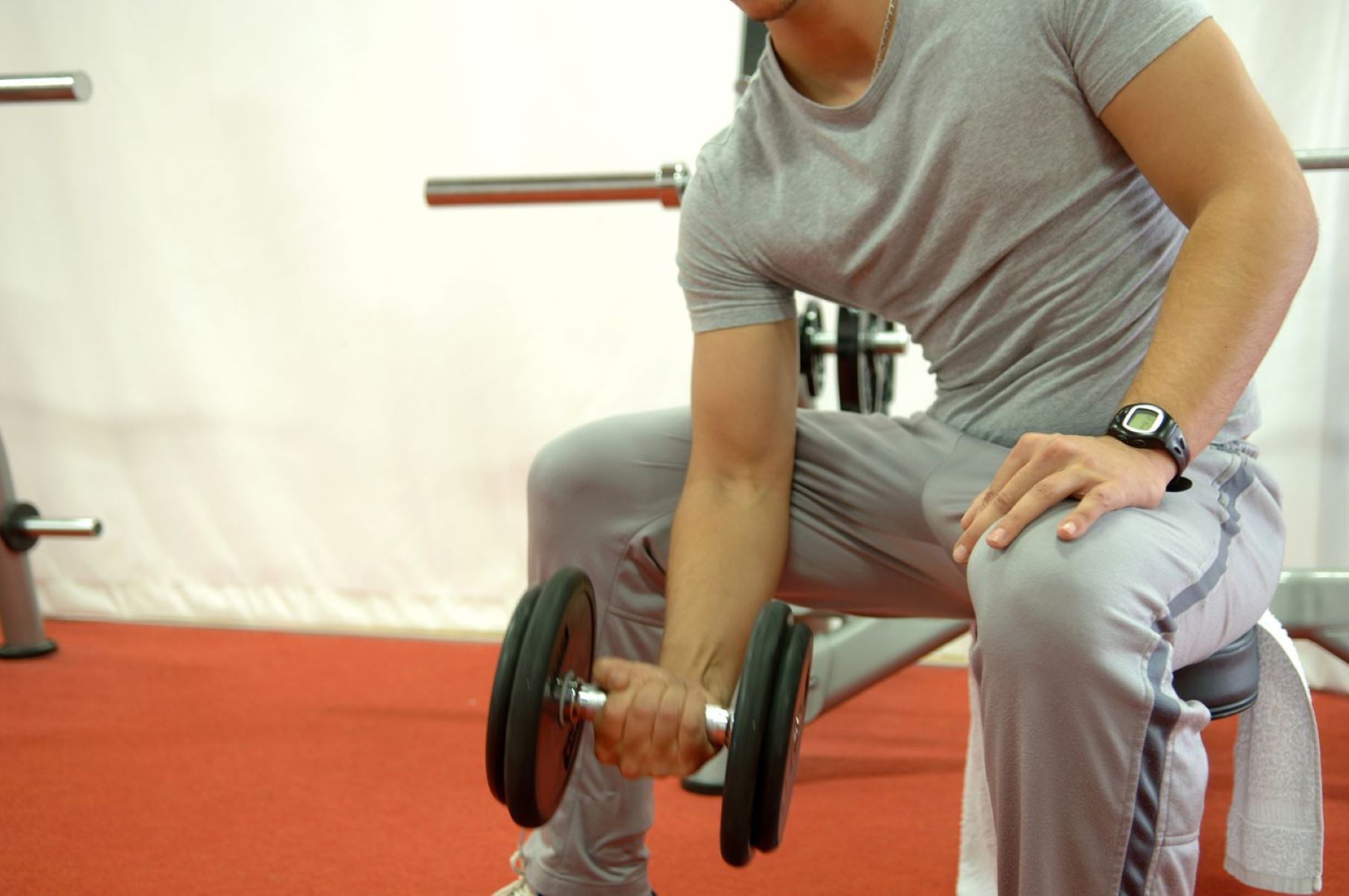Home>Misc>Featured>What Are The 5 Components Of Health Related Fitness?


Featured
What Are The 5 Components Of Health Related Fitness?
Published: September 7, 2023
Learn about the 5 key components of health-related fitness, including strength, endurance, flexibility, body composition, and cardiovascular health, with our featured article.
Introduction
When it comes to overall fitness, it’s important to understand the various components that contribute to a person’s well-being. While many people associate fitness with physical appearance or the ability to participate in athletic activities, there are actually five key components of health-related fitness that go beyond just how we look or how fast we can run. These components encompass different aspects of the body and its abilities, offering a well-rounded perspective on what it means to be truly fit.
Understanding and implementing these components into our fitness routines can help us achieve optimal health and enhance our overall quality of life. The five components of health-related fitness include cardiovascular endurance, muscular strength, muscular endurance, flexibility, and body composition. By focusing on improving each of these components, we can create a well-rounded fitness program that addresses all aspects of our physical well-being.
Whether you are just beginning your fitness journey or are a seasoned fitness enthusiast, learning about and incorporating these components into your routine can make a significant difference in your overall fitness level. Let’s delve deeper into each of the five components to gain a better understanding of their importance and how they contribute to our overall health.
Cardiovascular Endurance
Cardiovascular endurance refers to the efficiency of the cardiovascular system in delivering oxygen to the muscles and how well the muscles utilize that oxygen during prolonged physical activity. It is a measure of how effectively the heart, lungs, and circulatory system work together to supply oxygen-rich blood to the body’s tissues. By improving cardiovascular endurance, we enhance our ability to engage in activities that require continuous oxygen supply, such as running, swimming, or cycling.
Regular cardiovascular exercise, also known as aerobic exercise, helps to strengthen the heart muscle, increase lung capacity, and improve overall circulation. This can lead to a variety of health benefits, including reduced risk of heart disease, lowered blood pressure, improved cholesterol levels, and increased energy levels. Engaging in activities such as brisk walking, jogging, dancing, or participating in sports can help improve cardiovascular endurance.
When it comes to improving cardiovascular endurance, it is important to gradually increase the intensity and duration of the exercises. This allows the body to adapt and become more efficient in utilizing oxygen. Start by incorporating low-impact activities, such as walking or swimming, and gradually progress to more intense exercises, such as running or high-intensity interval training (HIIT).
Consistency is key when it comes to improving cardiovascular endurance. Aim for at least 150 minutes of moderate-intensity exercise or 75 minutes of vigorous-intensity exercise per week, as recommended by the American Heart Association. By including cardiovascular exercises in our fitness routine, we can strengthen our heart, improve our endurance, and enjoy the numerous health benefits that come with it.
Muscular Strength
Muscular strength refers to the maximum amount of force that a muscle can generate. It is a key component of health-related fitness and plays a crucial role in performing daily activities, as well as athletic endeavors. Improving muscular strength not only enhances our physical performance but also provides a host of benefits for overall health and well-being.
Resistance training, also known as strength training or weightlifting, is the primary method for increasing muscular strength. By challenging the muscles to overcome resistance, either through the use of weights, resistance bands, or bodyweight exercises, we can stimulate muscle growth and increase strength. Regular strength training exercises target specific muscle groups and promote the development of lean muscle mass.
There are numerous benefits to developing muscular strength. Strong muscles help improve our posture, stability, and balance, reducing the risk of falls and injuries. Additionally, increased muscle strength can enhance our metabolism, leading to improved weight management and overall body composition. It also plays a vital role in maintaining healthy bone density, reducing the risk of osteoporosis.
It’s important to note that building muscular strength doesn’t necessarily mean bulking up like a bodybuilder. Strength training can be tailored to individual goals, whether it’s toning, building lean muscle mass, or increasing overall strength and power. By progressively increasing the resistance and intensity of the exercises, we can continue to challenge our muscles and see improvements over time.
When engaging in strength training, it’s essential to allow for proper rest and recovery between sessions. This allows the muscles to repair and rebuild, leading to increased strength and muscle growth. Aim for at least two to three days of strength training per week, targeting all major muscle groups.
Remember, everyone starts at a different fitness level, and it’s important to start with manageable weights and gradually progress. Consult with a fitness professional to design a suitable strength training program that aligns with your goals and abilities.
Muscular Endurance
Muscular endurance is the ability of a muscle or group of muscles to perform repetitive contractions over an extended period. Unlike muscular strength, which focuses on maximum force output, muscular endurance emphasizes the duration and efficiency of muscle contractions. It plays a vital role in activities that require prolonged muscle use, such as running, cycling, or performing high-repetition exercises.
Improving muscular endurance not only enhances physical performance but also contributes to overall health and well-being. Regular resistance training and endurance-focused exercises help train the muscles to withstand fatigue, allowing us to sustain prolonged activity without experiencing significant muscle fatigue or loss of performance.
To enhance muscular endurance, it’s important to incorporate exercises that target specific muscle groups and involve high repetitions. This can include activities such as bodyweight exercises, circuit training, or using lighter weights with higher repetitions. The goal is to challenge the muscles to perform repeated contractions over an extended period, gradually increasing the duration and intensity of the exercises.
Benefits of muscular endurance training extend beyond improving physical performance. It can enhance our overall stamina and endurance, allowing us to engage in activities with less fatigue. It also aids in maintaining proper posture and form throughout exercises, reducing the risk of injuries and overuse strains.
It’s important to note that muscular endurance and muscular strength are interconnected but distinct components of fitness. While strength training focuses on maximum force output, muscular endurance training emphasizes the ability to sustain muscle contractions over time. Incorporating both types of training into a well-rounded fitness routine can offer comprehensive benefits for overall fitness and performance.
As with any fitness program, it’s crucial to gradually increase the intensity and duration of the exercises to avoid overexertion and injury. Consult with a fitness professional to design a tailored program that aligns with your goals and abilities. By incorporating exercises that improve muscular endurance into your routine, you can enhance your physical performance, boost overall stamina, and enjoy the benefits of an efficiently functioning muscular system.
Flexibility
Flexibility refers to the range of motion available in our joints and muscles. It is a vital component of health-related fitness that often gets overlooked. Having good flexibility allows us to move freely and perform daily activities with ease. It is important for overall mobility, posture, and injury prevention.
Regular stretching exercises are key to improving flexibility. Stretching helps elongate and relax the muscles, allowing them to move through their full range of motion. This not only enhances flexibility but also improves muscle coordination and joint stability.
There are various types of stretching exercises that can be incorporated into a flexibility routine. Static stretching involves holding a stretch for a set period, while dynamic stretching involves moving the joints and muscles through a controlled range of motion. Active stretching, where you use your own muscle strength to hold a stretch, and passive stretching, where you rely on external assistance or props, are also effective methods.
Flexibility training should target all major muscle groups, including the upper body, lower body, and core. It’s important to perform stretching exercises in a controlled and comfortable manner, avoiding any sharp or painful movements. Pay attention to proper form and alignment during stretches, as improper technique may lead to strain or injury.
Improved flexibility offers numerous benefits. It can enhance athletic performance by allowing muscles and joints to move more efficiently. It also helps to prevent muscle imbalances, reduces the risk of injury, and promotes better posture and alignment. Additionally, flexibility exercises can aid in relaxation, reducing muscle tension and promoting overall well-being.
It is important to note that flexibility levels can vary among individuals. Factors such as age, genetics, and previous injuries may affect one’s flexibility. However, with regular stretching and flexibility exercises, it is possible to improve flexibility and enjoy the associated benefits.
Incorporate stretching exercises into your fitness routine at least two to three times a week. Aim to hold each stretch for about 15-30 seconds, gradually increasing the duration over time. Remember to warm up your muscles before stretching and listen to your body’s limits, avoiding any excessive or painful stretches.
By prioritizing flexibility training, we can improve our overall range of motion, enhance physical performance, and promote better posture and alignment.
Body Composition
Body composition refers to the proportions of fat, muscle, bone, and other tissues that make up our bodies. It is an essential component of health-related fitness and provides valuable insights into our overall health and well-being. While body weight alone may not accurately reflect our level of fitness, understanding our body composition can help us assess our fitness level and make informed decisions about our health.
Having a healthy body composition is more than just maintaining a certain number on the scale. It is about achieving a balance between lean muscle mass and body fat percentage. A high proportion of lean muscle mass and a low amount of body fat contribute to better overall health and fitness.
Regular exercise, a balanced diet, and a healthy lifestyle are key factors in maintaining a healthy body composition. Strength training exercises play a crucial role in building and maintaining lean muscle mass while also increasing our metabolic rate. This helps us burn calories more efficiently, even at rest.
In addition to strength training, cardiovascular exercises can help burn excess body fat and improve heart health. By incorporating both types of exercise into our routine, we can maximize our body’s ability to build lean muscle and reduce fat stores.
Diet is also a critical component of achieving and maintaining a healthy body composition. A balanced diet that includes a variety of nutrient-dense foods can help fuel our workouts, support muscle growth and repair, and provide the necessary nutrients for overall health. It’s important to focus on consuming adequate protein to support muscle development, while also maintaining a calorie balance that supports our goals, whether it’s weight loss, muscle gain, or weight maintenance.
Regular assessment of body composition can be done through methods such as body fat calipers, bioelectrical impedance analysis, or dual-energy X-ray absorptiometry (DXA). These methods provide a more accurate picture of our body composition compared to relying solely on body weight.
It’s important to remember that body composition is individual and can vary based on factors such as age, genetics, and gender. Comparing oneself to unrealistic ideals or societal standards can be detrimental to our mental and emotional well-being. Focus on maintaining a healthy and sustainable body composition that supports overall health and fitness goals.
Remember, achieving and maintaining a healthy body composition is a journey that requires consistency, patience, and a holistic approach to health and fitness. By combining regular exercise, a balanced diet, and a positive mindset, we can work towards achieving a healthy body composition that supports our overall well-being.
Conclusion
Understanding the five components of health-related fitness – cardiovascular endurance, muscular strength, muscular endurance, flexibility, and body composition – is crucial for creating a well-rounded fitness routine. Each component plays a unique role in our overall physical well-being and contributes to our ability to perform various activities and maintain good health.
Improving cardiovascular endurance through aerobic exercises like running, swimming, or cycling can enhance heart health, increase lung capacity, and improve overall circulation. Muscular strength, on the other hand, focuses on maximum force output and is developed through resistance training. It helps improve posture, stability, and overall body composition.
Muscular endurance allows us to sustain muscle contractions over an extended period, supporting activities that require prolonged effort. Flexibility, often overlooked, is vital for maintaining joint mobility, preventing muscle imbalances, and reducing the risk of injury. Lastly, body composition is a measure of the proportions of fat, muscle, and other tissues in our bodies and plays a significant role in overall health and fitness.
By incorporating exercises targeting each component into our fitness routine, we can achieve optimal fitness levels and enjoy the numerous health benefits associated with them. However, it’s important to remember that fitness is a journey, and individual goals and abilities vary. It’s crucial to consult with a fitness professional to design a personalized program that aligns with our goals and ensures safe and effective progress.
Additionally, maintaining a balanced diet, proper hydration, adequate rest, and a positive mindset are key elements in achieving and maintaining optimal health-related fitness. With consistency, patience, and an understanding of the five components, we can enhance our overall well-being and lead a healthier, more active lifestyle.
So, embrace the journey, prioritize your fitness, and strive to improve your cardiovascular endurance, muscular strength, muscular endurance, flexibility, and body composition. Your body will thank you, and you will reap the rewards of a healthier, fitter, and more vibrant life.









